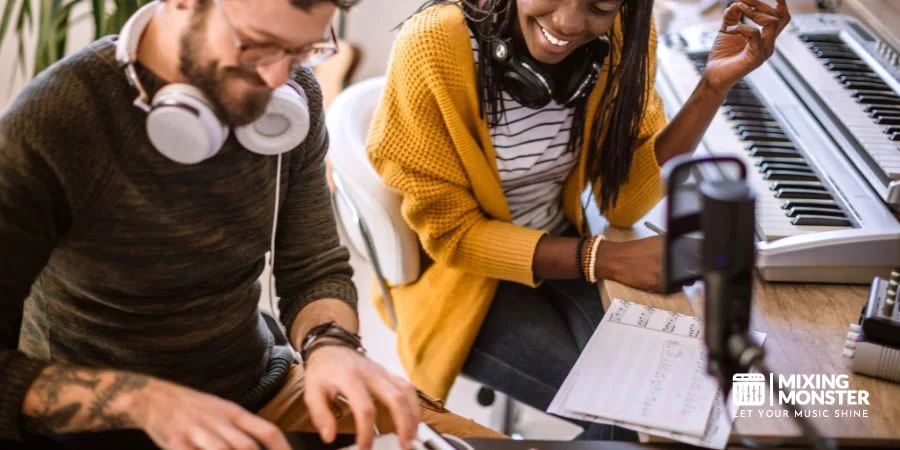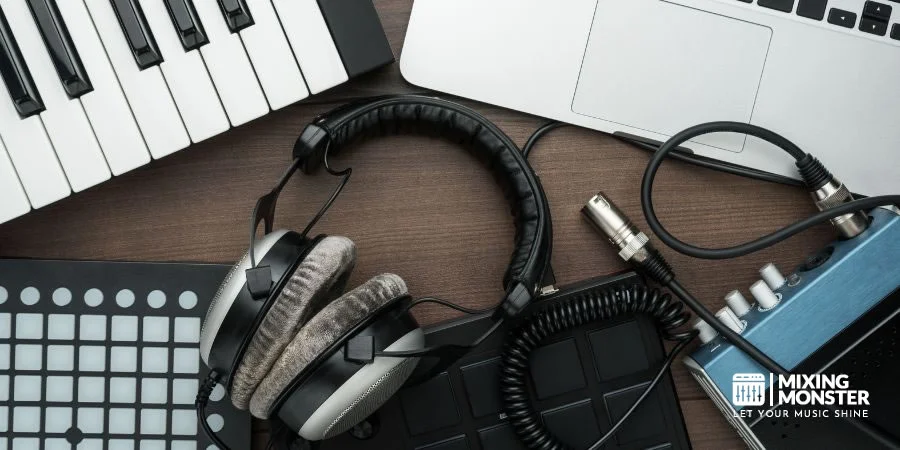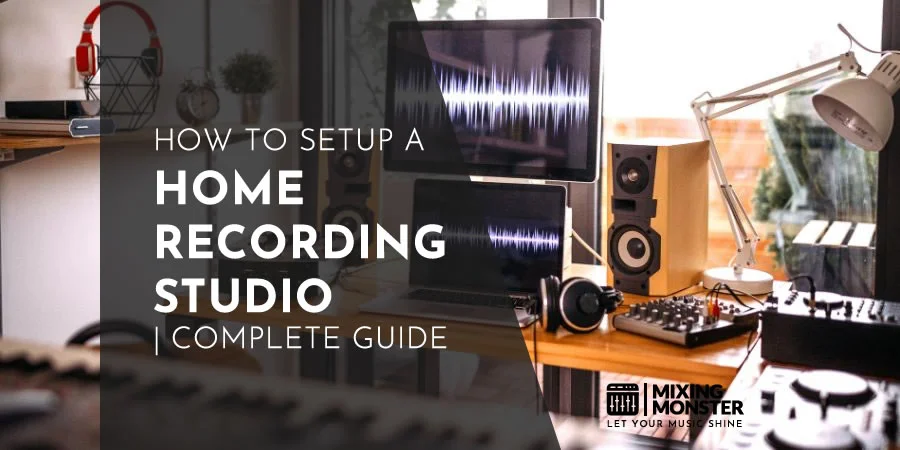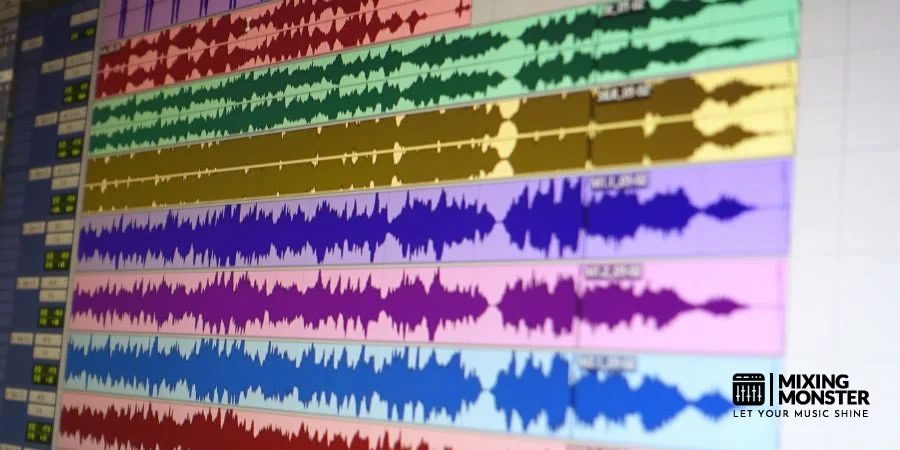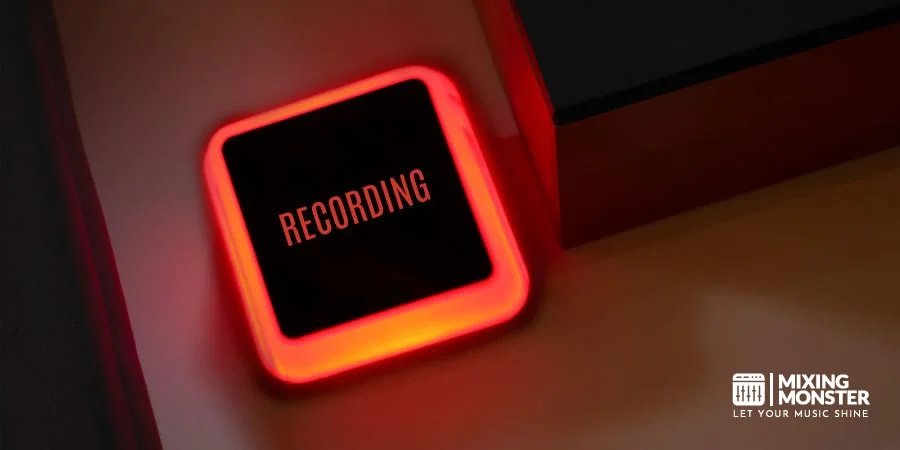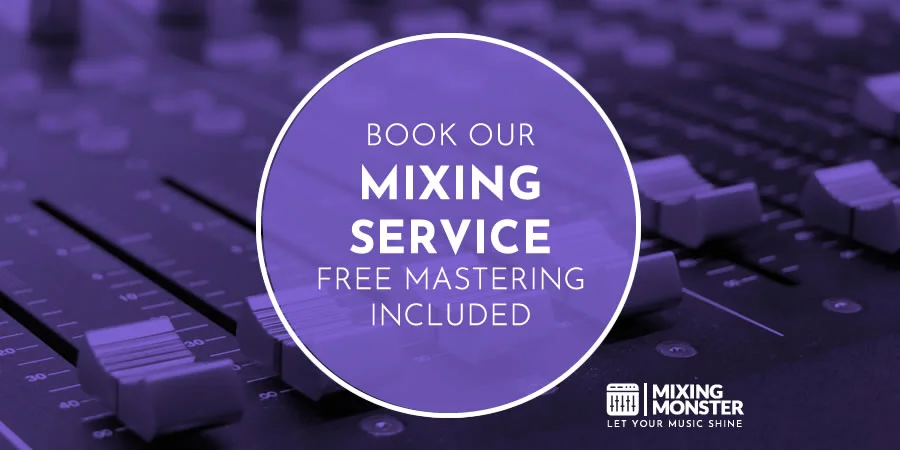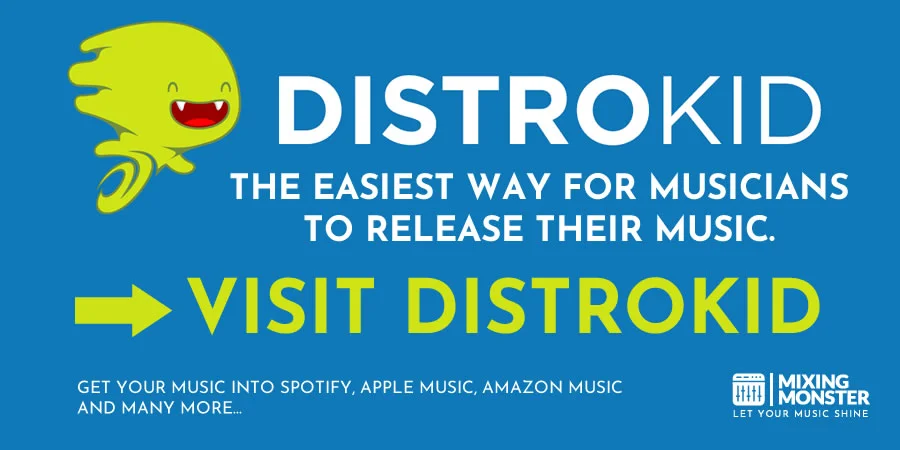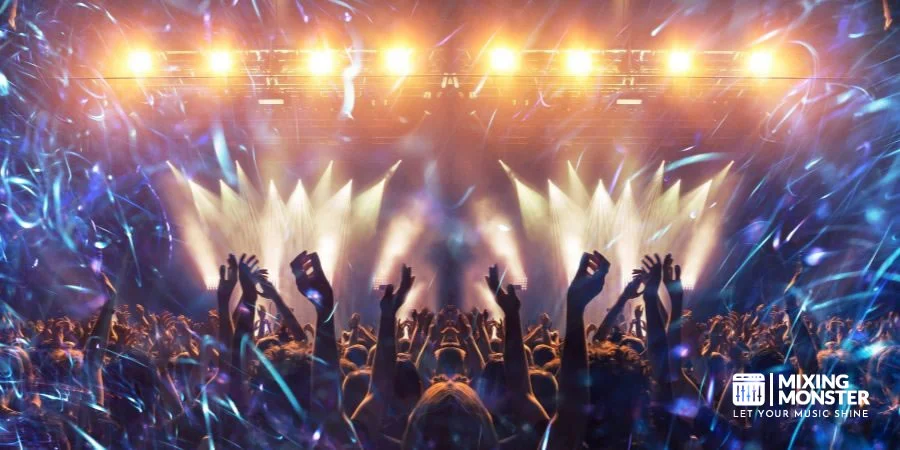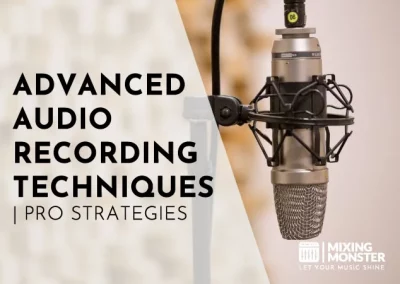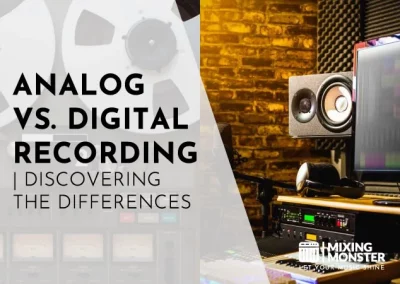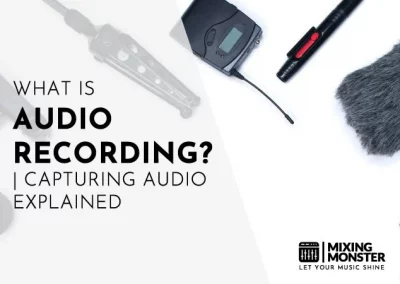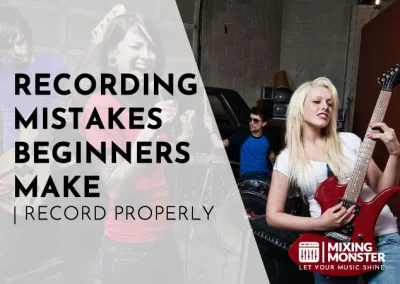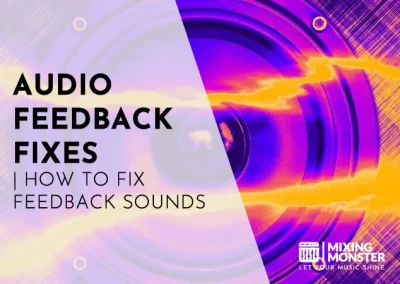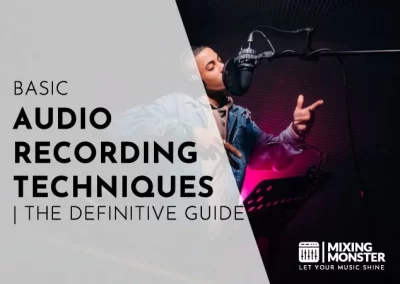Affiliate Disclaimer: We may earn a commission if you purchase through our links
Diving into the world of music creation has never been more accessible or exciting than it is right now. This practical beginner’s guide on how to record music is your key to unlocking this fascinating domain, providing step-by-step instructions and insights that will empower you to create your musical masterpieces. Whether you’re a novice, or a seasoned musician eager to explore new recording technologies, this comprehensive guide will illuminate the path to capture your audio.
Recording is an essential step in the music production process. How to record music involves setting up a home studio, selecting critical equipment, and using digital audio workstations (DAWs) for recording, editing, mixing, and mastering. To record music, there are basic concepts and techniques to understand.
Ever wondered how your favorite tunes are birthed into the world or how you could create your own captivating melodies? Uncover the magic behind music production and step into a realm where creativity meets technology as we delve into the art of recording music.
Table Of Contents
1. Introduction To How To Record Music
2. Understanding The Basics Of Music Recording
3. Essential Equipment For Music Recording
4. Setting Up Your Home Recording Studio
5. Software For Music Recording
6. Recording Your First Track
7. Mixing And Mastering – Enhance Your Recordings
8. Sharing Your Music
9. Your Next Steps In The Music Recording Journey
10. FAQ

1. Introduction To How To Record Music
Do you hear the rhythm of your heartbeat, the rustling leaves’ melody or the bustling city’s harmony? Music is everywhere, and the ability to capture it is a captivating journey that we are about to embark on.
What Is Music Recording?
In this digital age, learning how to record music is an essential skill for musicians and music enthusiasts alike. Music recording is the process of capturing sound, particularly musical performances, so it can be played back later. It’s like bottling up the magic of your musical genius so you can share it with the world.
Here’s another comprehensive article you might be interested in:
Why Recording Your Music Matters
Recording your music is not just about sharing your creative expression; it’s about leaving a legacy. Each recorded track is a piece of you etched in the fabric of time, ready to inspire future generations.
When you know how to record music, you gain control over your artistic voice, delivering your message exactly how you envision it. Plus, in this fast-paced digital world, recorded music can instantly reach the far corners of the globe, amplifying your impact and influence.
2. Understanding The Basics Of Music Recording
Ready to dive deeper into the ocean of music recording? Let’s start by familiarizing ourselves with the basic terms, the ABCs of how to record music. This is our shared language in this journey, helping us understand and communicate better.
Basic Terms In Music Recording
As with any field, music recording has its own lingo. Here are some essential terms that you’ll come across frequently:
Sampling Rate
Think of it as the number of snapshots taken of the sound per second. The higher the sampling rate, the more detail captured, resulting in a more accurate digital representation of the original sound.
Typical rates are 44.1 kHz (CD quality) or 48 kHz, but higher rates like 96 kHz or even 192 kHz are sometimes used for professional recording.
Bit Depth
This represents the amount of information in each snapshot. A higher bit depth provides a broader dynamic range, allowing quieter sounds to be recorded without getting lost in the noise. Standard bit depths are 16-bit (CD quality) and 24-bit for professional recording.
Channels
Channels refer to the individual tracks of audio. A mono recording has one channel, while a stereo recording has two: one for the left speaker and one for the right. Multichannel recordings, used in surround sound systems, can have six or more channels.
In the next section, we’ll explore the essential equipment for music recording. Can’t wait? Neither can we! Let’s move on.

3. Essential Equipment For Music Recording
Learning to record music without the right tools would be like trying to paint a masterpiece without a brush. Let’s explore the essential equipment to start recording your music.
Choosing Your Instrument(s)
The instrument is the heart and soul of your recording. It could be your voice, a guitar, a piano, or anything that produces the sounds you wish to capture. Choose an instrument that you’re comfortable with, and that suits the style of music you want to create.
Microphones And Their Uses
Microphones are the ears of your recording setup, picking up sound and converting it into an electrical signal.
Different types of microphones exist, such as dynamic mics for loud sources like drums and condenser mics for capturing vocal and acoustic instrument details. The kind of microphone you choose can significantly affect the sound quality.
Audio Interfaces
The audio interface is the bridge between your microphone and your computer. It converts the analog signal from your microphone into a digital signal that your computer can process.
Look for an interface with good preamps and suitable input/output options.
Headphones And Monitors
Finally, you’ll need something to listen to your recording.
High-quality headphones provide a detailed listening experience for tracking and mixing. Studio monitors, meanwhile, give a more accurate representation of your sound in a room, which is crucial for mixing and mastering.
Investing in the equipment for music recording is helpful to record music properly, ensuring your tracks are captured correctly and ready for further processing. Remember that your skills and critical listening abilities are just as essential as the tools you use.
These tools are your companions in learning how to record music. The following section looks at setting up your home studio. Ready to build your creative haven? Let’s go!

4. Setting Up Your Home Recording Studio
Welcome to the most exciting learning phase of recording music: setting up your home studio! This is where the magic happens, your personal space to transform sounds into emotions.
Choosing The Right Location
Location matters, and not just in real estate! The room you select for your home studio will significantly impact your recording quality.
Look for a quiet, spacious room with minimal outside noise and good acoustics. Avoid rooms with many hard surfaces (blank walls, windows, mirrors), which can lead to excessive echo and reverberation.
Soundproofing Your Studio
Soundproofing minimizes external noise interference in your recording and prevents your music from disturbing others. You can use foam panels, diffusers, bass traps, heavy curtains, and carpets. The goal is to create a balanced sound environment that’s both alive and lively.
Arranging Your Equipment
The positioning of your equipment is crucial for a functional and efficient recording environment. Place your desk in the middle of the longest wall, facing forward. Your monitors should form an equilateral triangle with your ear-level sitting position. Keep your instruments, mics, and other equipment within easy reach.
If you want to learn more about how to set up a home recording studio, here is a complete guide for you:
Setting up your home studio is a significant step in your journey to record music. In the next section, we’ll dive into the digital world, exploring software for music recording.
Are you ready to turn your computer into a recording powerhouse? Let’s get to it!

5. Software For Music Recording
As we move forward on our journey of how to record music, it’s time to explore the digital realm. The right software can turn your computer into a complete recording studio. Learning how to record music on your computer is essential. Let’s dive in!
DAW (Digital Audio Workstation) Overview
A Digital Audio Workstation (DAW) is software that enables you to record, edit, mix, and master music on your computer. DAWs offer a range of tools for manipulating audio, creating virtual instruments, adding effects, and much more. It’s like the canvas where you paint your musical ideas.
Popular DAWs
There are many DAWs available, each with its strengths.
Some popular ones include Pro Tools, known for its professional-grade capabilities. Pro Tools is our clear recommendation when it comes to choosing a DAW; Ableton Live, favored for electronic music production; and Logic Pro, a comprehensive tool for Mac users. Consider your needs, budget, and the learning curve when choosing a DAW.
Our clear recommendation would be to choose a suitable digital audio workstation (DAW) for your needs, learn how to use it properly and continue from there.
Recording Software For Beginners
If you’re starting, you might prefer beginner-friendly software. GarageBand is a great free option for Mac users, offering a user-friendly interface and a wide range of instruments and effects.
Audacity, another free software, is available for all platforms and provides essential recording and editing tools.
Having covered the digital landscape, we’re ready to record our first track. Excited? You should be! Let’s make some music!
6. Recording Your First Track
Having gathered the knowledge and tools, you’re ready to put it together. In this chapter of our guide on how to record music, we will create your very first recording.
Preparing To Record
Before hitting the record button, there are a few things to set up:
First, tune your instrument and warm up your voice. Check your audio levels to ensure they’re neither low (quiet recording) nor too high (clipping). Set the correct sample rate and bit depth in your DAW.
Recording Techniques
Various recording techniques depend on your instrument and the sound you aim for.
For vocals, a pop filter can help reduce plosive sounds. For acoustic guitar, try different mic positions to find the sweet spot. Always do a few test recordings before the final take.
Multitracking And Overdubbing
Multitracking is the process of recording different parts of your song separately.
Overdubbing adds layers to these tracks, like recording backing vocals over the main vocal track. These techniques allow you to build complex musical pieces one layer at a time.
Congratulations! You’ve made your first recording. But the journey doesn’t end here. The following section enhances your track through mixing and mastering. Ready to polish your diamond in the rough? Let’s do it!
Hitting The Record Button
Pressing the record button might seem like a simple step in the process of how to record music, but it’s so much more than that.
It’s the culmination of your preparation and the beginning of your creative output. It’s the moment when your ideas and emotions transform into a tangible form that can be shared and experienced by others.
When you’re ready to hit the record button, ensure your equipment is correctly set up. Your instrument is tuned, your microphone is positioned perfectly, and your audio levels are appropriately set.
Remember, not every recording has to be perfect. But beyond the technicalities, hitting the record button is also about mindset. It’s about embracing the possibility of making mistakes and learning from them.
You improve and grow as a musician and a recording artist through making and analyzing errors.
So, when you’re ready, take a deep breath, focus, and press that record button! Embrace the journey of creation, for this is where your music truly comes to life.

7. Mixing And Mastering – Enhance Your Recordings
So, you’ve recorded your first track. Exciting, right? But recording is just the first step. In this chapter on how to record music, we’ll transform your raw recording into a polished gem through mixing and mastering.
The Art Of Mixing
Mixing is the process of balancing the various elements in your recording. You’ll adjust levels, pan tracks for a stereo image, and add effects like reverb or delay.
The goal is to create a cohesive whole where each part complements the others rather than competing for attention.
If you need help mixing your music projects, consider using our online mixing service, which caters to musicians of all levels.
Our experienced audio engineers and advanced technology can help bring out the best in your recordings, providing a professional touch to your work.
While it’s essential to hone your mixing skills, don’t hesitate to use our services when you need assistance achieving the perfect sound for your projects:
Get Your Songs Mixed By Mixing Monster (Incl. FREE Mastering)
The Role Of Mastering
Mastering is the final step before your music is ready for the world. It involves adjusting the overall level, EQ, and dynamics to ensure your music sounds good on all playback systems.
A well-mastered track sounds balanced, complete, and cohesive.
If you need help mastering your music projects, consider using our online mastering service, which caters to musicians of all levels.
Our experienced audio engineers and advanced technology can help bring out the best in your mixes, providing the best professional touch to your work.
While it’s essential to hone your mastering skills, don’t hesitate to use our services when you need assistance achieving the perfect sound for your projects:
At some point, you’ve transformed your raw recording into a polished track. It’s a journey of creativity and technical skill, bringing your musical ideas to life.
But what’s a song if no one can hear it? In the next section, we’ll explore how to share your music with the world. Ready to let your music fly? On to the next step!
8. Sharing Your Music
You’ve learned how to record music on computer, from setting up your home studio to mixing and to mastering your first track. Now, it’s time for the world to hear your creation.
Let’s explore how to share your music.
Platforms For Sharing Your Music
There are numerous online platforms to upload your music, such as SoundCloud, Bandcamp, and YouTube. Streaming platforms like Spotify and Apple Music are also popular.
Each platform has advantages, so consider your audience and the type of music you produce when choosing where to share.
Consider releasing your music through DistroKid, a service that will automatically distribute your music to all streaming platforms simultaneously!
Marketing Your Music
Sharing your music is just the first step – you also need to promote it.
Use social media to connect with fans, share behind-the-scenes content, and announce new releases. Collaborate with other artists and consider live performances to reach a wider audience. Remember, consistency and engagement are essential.
Congratulations! You’ve completed learning how to record music and share it with the world. But this is just the beginning – there’s always more to learn and explore in the world of music. Ready for the next step? Let’s wrap things up in our final section.
9. Your Next Steps In The Music Recording Journey
As we reach the end of our guide on how to record your own music, it’s time to reflect on the journey you’ve embarked upon. You’ve achieved so much, from understanding the basics to sharing your music with the world!
The Recording Journey Ahead
Remember, learning to record music is a journey, not a destination. There’s always more to learn, create, and explore.
Keep experimenting, keep learning, and most importantly, keep creating. The world is waiting to hear your music.
And there you have it! You now have the tools and knowledge to start your journey in recording music. But don’t stop here; continue to hone your skills, experiment with new techniques, and let your creativity flow.
Learn how to record music and start recording music today!

10. FAQ
- What Is The Best Software For Music Recording For Beginners?
Numerous options are available, but some beginner-friendly choices include GarageBand (for Mac users) and Audacity (for all platforms). These offer intuitive interfaces and essential tools for recording and editing.
- Do I Need Expensive Equipment To Start Recording Music?
No, you don’t necessarily need expensive equipment to start. A basic setup with a decent microphone, an audio interface, headphones, and a computer with a DAW (Digital Audio Workstation) is enough to start recording your music.
- How Can I Improve The Sound Quality Of My Home Recordings?
Sound quality can be improved by proper microphone positioning, soundproofing your recording space, using a good audio interface, and learning to mix and master your tracks in your DAW.
- Is It Necessary To Learn Mixing And Mastering?
While it’s optional to learn mixing and mastering to record music, understanding these processes can significantly enhance the quality of your recordings. Mixing balances the elements of your track, and mastering ensures it sounds good across various playback systems.
- How Do I Share My Music Once It’s Recorded?
Remember, sharing is just the first step – effectively promoting your music is also crucial. There are many online platforms like SoundCloud, Bandcamp, and YouTube where you can share your music. Streaming services like Spotify and Apple Music are also popular. Consider DistroKid to get your music into all of these platforms!


